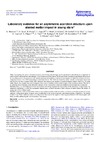Please use this identifier to cite or link to this item:
https://accedacris.ulpgc.es/jspui/handle/10553/75151
| Title: | Laboratory evidence for an asymmetric accretion structure upon slanted matter impact in young stars | Authors: | Burdonov, K. Revet, G. Bonito, R. Argiroffi, C. Beárd, J. Bolanõs, S. Cerchez, M. Chen, S. N. Ciardi, A. Espinosa, G. Filippov, E. Pikuz, S. Rodriguez, R. Šmíd, M. Starodubtsev, M. Willi, O. Orlando, S. Fuchs, J. |
UNESCO Clasification: | 21 Astronomía Astrofísica | Keywords: | Accretion Accretion Disks Instabilities Magnetohydrodynamics (Mhd) Shock Waves, et al |
Issue Date: | 2020 | Project: | Horizon 2020 (787539) | Journal: | Astronomy & astrophysics (Print) | Abstract: | Investigating the process of matter accretion onto forming stars through scaled experiments in the laboratory is important in order to better understand star and planetary system formation and evolution. Such experiments can indeed complement observations by providing access to the processes with spatial and temporal resolution. A previous investigation revealed the existence of a two-component stream: a hot shell surrounding a cooler inner stream. The shell was formed by matter laterally ejected upon impact and refocused by the local magnetic field. That laboratory investigation was limited to normal incidence impacts. However, in young stellar objects, the complex structure of magnetic fields causes variability of the incident angles of the accretion columns. This led us to undertake an investigation, using laboratory plasmas, of the consequence of having a slanted accretion impacting a young star. Methods. Here, we used high power laser interactions and strong magnetic field generation in the laboratory, complemented by numerical simulations, to study the asymmetry induced upon accretion structures when columns of matter impact the surface of young stars with an oblique angle. Results. Compared to the scenario where matter accretes perpendicularly to the star surface, we observe a strongly asymmetric plasma structure, strong lateral ejecta of matter, poor confinement of the accreted material, and reduced heating compared to the normal incidence case. Thus, slanted accretion is a configuration that seems to be capable of inducing perturbations of the chromosphere and hence possibly influencing the level of activity of the corona. | URI: | https://accedacris.ulpgc.es/handle/10553/75151 | ISSN: | 0004-6361 | DOI: | 10.1051/0004-6361/202038189 | Source: | Astronomy and Astrophysics [ISSN 0004-6361], v. 642, A38 (Octubre 2020) |
| Appears in Collections: | Artículos |
SCOPUSTM
Citations
8
checked on Jun 8, 2025
WEB OF SCIENCETM
Citations
6
checked on Jun 8, 2025
Page view(s)
244
checked on May 31, 2025
Download(s)
166
checked on May 31, 2025
Google ScholarTM
Check
Altmetric
Share
Export metadata
Items in accedaCRIS are protected by copyright, with all rights reserved, unless otherwise indicated.
